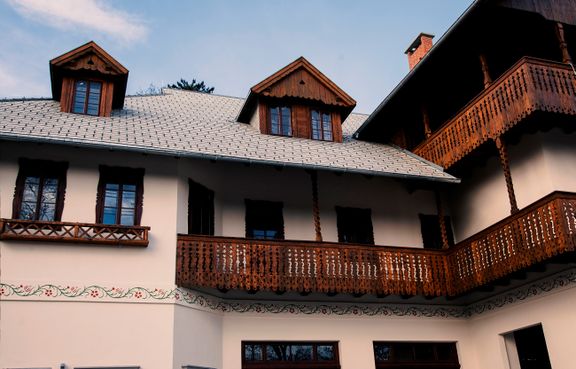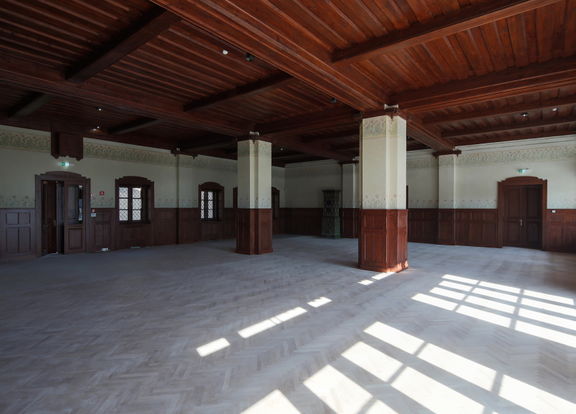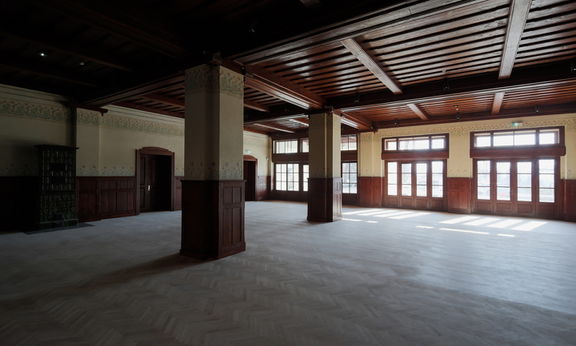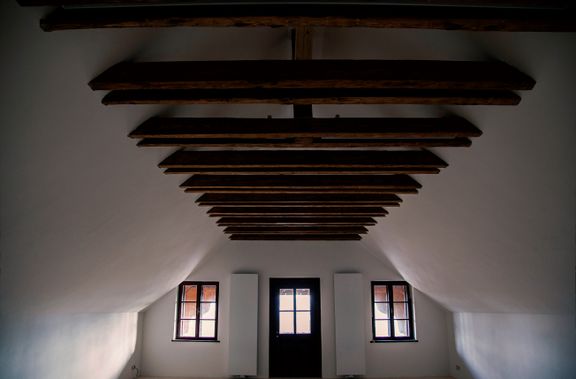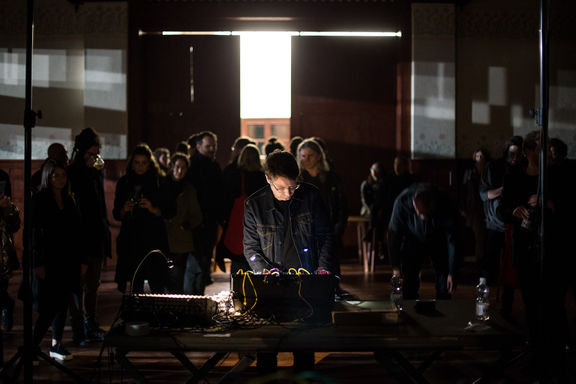Difference between revisions of "Švicarija Art Centre"
Anže Zorman (talk | contribs) (Sketch, to be further elaborated) |
Anže Zorman (talk | contribs) (Finished) |
||
| Line 29: | Line 29: | ||
{{Teaser| | {{Teaser| | ||
| + | Occupying the premises of a renovated, early 20th century hotel, [[Švicarija Art Centre]] is a newly established arts venue in Ljubljana. Opening its doors in June [[established::2017]], the place is managed by the [[International Centre of Graphic Arts, Ljubljana|International Centre of Graphic Arts]], situated in its immediate vicinity – in the very heart of the Tivoli Park in Ljubljana. | ||
| − | + | Set out to be a multi-purpose venue, Švicerija – with its three residency apartments and approximately ten production spaces – is foremost meant for resident artists. However, there is also an exhibition space as well as a cafeteria. | |
| − | |||
| − | |||
| − | |||
| − | Set out to be a multi-purpose venue, Švicerija – with its three residency apartments and approximately ten | ||
}} | }} | ||
==History== | ==History== | ||
| − | + | Švicarija's history goes all the way back to the year 1835. A wooden inn was then built on the order of the Czech field marshal Josef Radetzky, the master of the nearby [[Tivoli Mansion]]. Meant to be his summer house, it was done in the so called "Swiss" style and was dubbed as the Laibach Schweizerhaus. The inn soon became a popular place for cultural events and socialising. | |
| + | |||
| + | The current building, designed as a hotel by the architect [[Ciril Metod Koch]], was raised nearby in 1910, with the original inn then demolished. However, the name Švicarija somehow got transferred to the newly constructed hotel. It's secession tinged look is somewhat reminiscent of typical Slovene houses in the Alpine region and this so called "folk style" is due to the Ljubljana major [[Ivan Hribar]], who wanted the building to reflect the Slovene independence aspirations. | ||
| − | + | In 2013 Švicarija was proclaimed to be a cultural monument of local significance. The subsequent renovation, led by [[Studio AKKA]], more or less retained the original look, though a white facade replaced the yellow one, which was done in the 1940s. | |
| − | + | ===Previous art-related activities=== | |
| − | + | For its first two decades the place operated as a hotel (quite a many well known artist lived in it, among them the writer [[Ivan Cankar]]) as well as a restaurant, a popular dance hall and concert venues. There were literary, theatre and other cultural events, including painting exhibitions. After 1930 it ceased to be a hotel and it uses ranged from hosting Russian emigrants to serving for social housing. After WW2 (and up until 2008) many of its occupants were artists who also had their studios there (like the sculptors [[Karel Putrih]], [[Zdenko Kalin]], [[Stojan Batič]], [[Alojzij Kogovšek]], [[Drago Tršar]], [[Lujo Vodopivec]], and [[Jakov Brdar]], all of them authors of prominent public sculptures in Ljubljana). | |
==Programme== | ==Programme== | ||
| − | The mansion's opening is set to coincide with the | + | The mansion's official opening is set to coincide with the start of the [[Biennial of Graphic Arts]]. Soon after artists will get their residency spaces (some offered for short terms and others for longer periods) and a programme of contemporary arts exhibitions will be set in motion. |
| − | There are 2230 square meters of space and 17 working units. The ground floor | + | There are 2230 square meters of space and 17 working units. The ground floor is intended for workshops, educational programmes, exhibitions and other events. A small restaurant is located in the central area. Art and sculpture studios are located in the basement and the first floor, next to four residential studios. Two of them are intended exclusively for young artists. |
== See also == | == See also == | ||
| Line 62: | Line 61: | ||
== External links == | == External links == | ||
| − | * http://zgodovinanadlani.si/tag/svicarija/ Old postcards related to | + | * [http://zgodovinanadlani.si/tag/svicarija/ Old postcards related to Hotel Tivoli] (in Slovene) |
| − | * http://siol.net/trendi/kultura/sto-let-star-alpski-hotel-sredi-ljubljane-bo-kmalu-zazivel-na-novo-430482 An article | + | * [http://siol.net/trendi/kultura/sto-let-star-alpski-hotel-sredi-ljubljane-bo-kmalu-zazivel-na-novo-430482 An article on the history of Švicarija] (in Slovene) |
* [https://misli.sta.si/2358926/prenovljena-svicarija-bo-poleti-zazivela-z-graficnim-bienalom An article on the Švicarija reconstruction] (in Slovene) | * [https://misli.sta.si/2358926/prenovljena-svicarija-bo-poleti-zazivela-z-graficnim-bienalom An article on the Švicarija reconstruction] (in Slovene) | ||
* [http://akka.si/SL/svicarija/ Studio AKKA's Švicarija project page] | * [http://akka.si/SL/svicarija/ Studio AKKA's Švicarija project page] | ||
Revision as of 13:42, 12 April 2017
History
Švicarija's history goes all the way back to the year 1835. A wooden inn was then built on the order of the Czech field marshal Josef Radetzky, the master of the nearby Tivoli Mansion. Meant to be his summer house, it was done in the so called "Swiss" style and was dubbed as the Laibach Schweizerhaus. The inn soon became a popular place for cultural events and socialising.
The current building, designed as a hotel by the architect Ciril Metod Koch, was raised nearby in 1910, with the original inn then demolished. However, the name Švicarija somehow got transferred to the newly constructed hotel. It's secession tinged look is somewhat reminiscent of typical Slovene houses in the Alpine region and this so called "folk style" is due to the Ljubljana major Ivan Hribar, who wanted the building to reflect the Slovene independence aspirations.
In 2013 Švicarija was proclaimed to be a cultural monument of local significance. The subsequent renovation, led by Studio AKKA, more or less retained the original look, though a white facade replaced the yellow one, which was done in the 1940s.
For its first two decades the place operated as a hotel (quite a many well known artist lived in it, among them the writer Ivan Cankar) as well as a restaurant, a popular dance hall and concert venues. There were literary, theatre and other cultural events, including painting exhibitions. After 1930 it ceased to be a hotel and it uses ranged from hosting Russian emigrants to serving for social housing. After WW2 (and up until 2008) many of its occupants were artists who also had their studios there (like the sculptors Karel Putrih, Zdenko Kalin, Stojan Batič, Alojzij Kogovšek, Drago Tršar, Lujo Vodopivec, and Jakov Brdar, all of them authors of prominent public sculptures in Ljubljana).
Programme
The mansion's official opening is set to coincide with the start of the Biennial of Graphic Arts. Soon after artists will get their residency spaces (some offered for short terms and others for longer periods) and a programme of contemporary arts exhibitions will be set in motion.
There are 2230 square meters of space and 17 working units. The ground floor is intended for workshops, educational programmes, exhibitions and other events. A small restaurant is located in the central area. Art and sculpture studios are located in the basement and the first floor, next to four residential studios. Two of them are intended exclusively for young artists.
See also
- International Centre of Graphic Arts, Ljubljana
- Biennial of Graphic Arts
- Municipality of Ljubljana
- Studio AKKA
External links
- Old postcards related to Hotel Tivoli (in Slovene)
- An article on the history of Švicarija (in Slovene)
- An article on the Švicarija reconstruction (in Slovene)
- Studio AKKA's Švicarija project page




